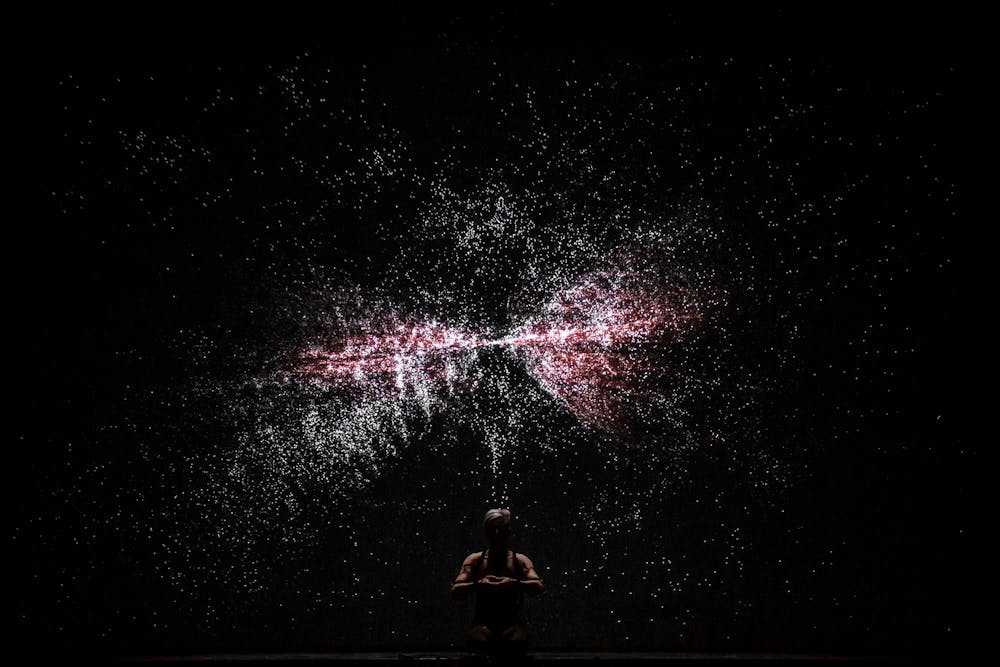See the stage. As the ceiling lights dim, the smatterings of chatter fizzles out, and Page Auditorium is brought to a silent twilight. On stage, a translucent screen like a shrouded portal. A lone red dot appears, pulsing. From looming speakers, soft white noise begins growing into a rhythmic hum. Another red dot joins, pulsing. The rhythm of the music follows. Another red light. Then another. Then another. Then thousands populate the screen, the hum crescendoing, mesmerizing the audience, louder, louder, louder. The screen is a colony of red lights, flowing, dancing, whorling, in randomness. Then BOOM. Silence. The lone performer jogs to center stage, the red lights suspended, frozen, on the translucent screen before her and the backdrop behind. The music relaxes. Audience shoulders untense. Soft white light begins to sweep across the screen, left-to-right, like oceanic currents. And the performer, slowly, begins to command the light.
In early November, Duke Performances hosted DÖKK — the Icelandic word for ‘darkness,’ and a multimedia performance of intertwining light, music and physical movement — envisioned and produced by Italian digital art studio and production company fuse*. The live performances interfuse technology and art into a unique entity. To inspire in the audience a profound sense of randomness and stimulation, the lighting of each performance is built in real time as fuse* software synthesizes data from the show’s score, the performer’s movement, her heartbeat, and an emotional analysis of global social media at that moment. Picture the sentiment analysis as an invisible string connecting the stage to the grander events of the world — each moment, tweets on trending topics filter through an algorithm structured by an open-source library from Uroš Krčadinac, a Serbian-based digital artist, technologist, writer, and educator. The light and sound is a microcosm for the world’s mood…
DÖKK belongs to a skyrocketing cohort of computational art, in which creatives utilize variables and software with the same intention Picasso wielded his brush and Michelangelo his chisel…
In an ensnaring vignette, DÖKK illustrates “Everything that surrounds us is nothing but a collection of atoms, particles and electromagnetic fields, vibrating without any apparent meaning. When these impulses are interpreted by our mind, they become…the foundations of what each one of us perceives as reality.” Reality fluctuated some in Page Auditorium that Sunday. Relaxation, catharsis, excitement, introspection — the takeaways as innumerous and complex as the beads of light frollicking the screen…
See the artistic acrobat Erika Ravot contort with the light beams as they contort with her. With the vibes of a sci-fi-warrior-renegade-princess, she flows and fights in dance, her heart controlling the experience in two ways. A rope breaks her compliance with gravity, and she is flying alongside the photons, flipping, soaring, twirling.
“I don’t know about you all…but that was damn cool.” the woman seated behind me commented. As a respite from midterms and essays, Duke Performances scores once more, and lucky for you, performance season is every season. Performances will return Dec. 3 with the Isidore String Quartet in Baldwin Auditorium. Plus, just announced, 24 productions will play this spring semester — ranging from hallucinogenic Alice in Wonderlands to folk luminaries and oral storytelling to the enduring glory of the ballet. For students, most performances, and a break from reality, are a discounted, $10 ticket away.
Get The Chronicle straight to your inbox
Signup for our weekly newsletter. Cancel at any time.

